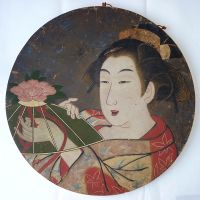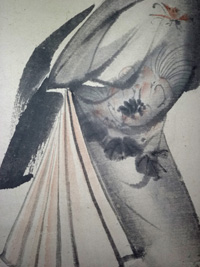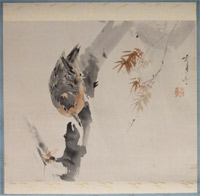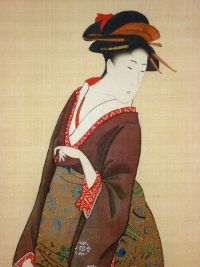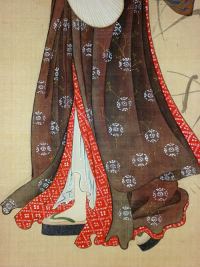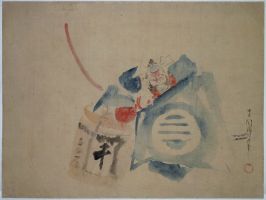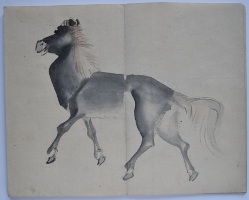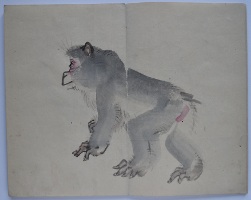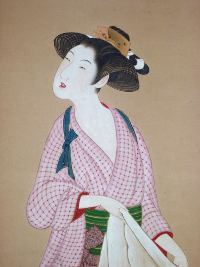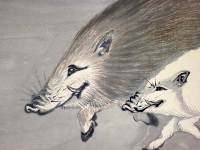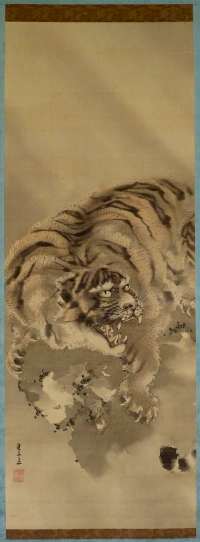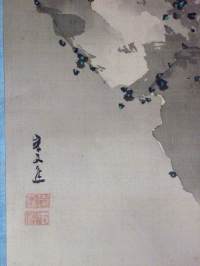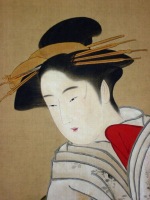/category/paintings/page/2/
Cho GESSHO (1772-1832)
Click here to view image full size.
A large original painting of moored junks caught in a violent squall. A fine painter who studied under Tanke Gessen and Matsumura Goshun in Kyoto before moving to Nagoya in 1798 and becoming Nagasawa Rosetsu’s assistant for a short time. Also illustrated some fine ehon. Sumi and colour on silk with the currents of air painted in gold; 55.25 x 26 in; 140.25 x 66 cms. Painted c. 1810s. Provenance: Two previous owners’ seals on the exterior of mount: The Honda family library and the Ueno family. Old box with inscription which states that Gessho wanted to acquire a painting from the Owari district. Although not intrinsically valuable it was esteemed by the local people. He offered to exchange the painting offered here for their painting. There is a dig here in that the inhabitants of Owari were known to be avaricious. Written by Mizutani Okurei (1848-1926). Presumably based on the accounts of the two previous family owners.
Signed Gessho with seal: Yukisada, Genkei, Gessho. Obviously an important painting by Gessho and in very good condition.
Status: Available
Nishiyama HOEN (1804-1867)
Click here to view image full size.
An original painting showing the oiran Eguchi on a white elephant. The origins of this story seem to go back to a recorded conversation the poet-monk Saigyo (1118-1190) had with a prostitute named Eguchi giving rise to numerous legends. Eguchi is shown as a manifestation of the Budhisattva Fugen whose usual vehicle is a large white elephant. Hoen, one of the best shijo painters of his time, lived in Osaka and was a pupil of Keibun. Full colour on silk, 36.5 x 13 in; 92.7 x 33 cms. Mount showing signs of wear but image in good condition. Signed Hoen with seal (?) – Seisho.
Status: Available
Yanagawa SHIGENOBU (1787-1833)
Click here to view image full size.
An original painting by this artist who was the pupil and then son-in-law of Hokusai. He was given the name Yanagawa (from his residence in the Honjo district of Edo) to distinguish him from other Shigenobu artists. A good book illustrator and surimono designer. He designed the first square surimono in Osaka in 1822, inspiring others to follow. His paintings are rare. Shows a portrait of the Japanese scholar and writer Ishikawa Masamochi (1754-1830). The fifth son of Ishikawa Toyonobu, he was a renowned kyoka poet and Gesaku writer (playful, mocking works), including The Magical Carpenter of Japan. An important figure in kyoka/surimono circles. Known as Rokujuen (Yadao no Meshimori). His family crest is seen on his kimono and he sits before a low desk ready to write. A high quality painting, sumi and colour on silk, 29 x 12.5 in.; 73.6 x 31.8 cms. Several small backed wormholes at bottom, otherwise very good condition. Would benefit from being remounted.
Signed Shigenobu with seal Yanagawa.
Status: Available
ANONYMOUS (Late 18th century)
Click here to view image full size.
An Uki-e, “floating picture” painting showing an interior with a puppet performance taking place. A puppeteer manipulates a female puppet in the centre, behind him two gidayu narrators and a shamisen player. A male puppet is being held behind a screen. Ladies behind a screen at right enjoy the drama. In fact, a male individual at the back seems overcome by emotion with a hanky to his face. The architecture is represented using one-point perspective, a style which made its way to Japan in the 1740’s from the West via China. (Interestingly the artist has got the perspective wrong on the screen at right.) This genre of painting – invariably unsigned – always shows interior or semi-interior views with banquets or, as here, puppet performances. Full colour on paper, 17 x 23 in; 43.2 x 58.5 cms. Minor marks, although good condition for this kind of painting.
Status:
Available

Click here to view image full size.
Tsukioka SETTEI (1710-1786)
Click here to view image full size.
An original painting, sumi and light blue on silk. Image size 38.75 x 14.25 in; 98.4 x 36.2 cms. Shows a carp leaping a waterfall. This was a favourite subject for Japanese artists being a symbol of achievement against adversity. Carp were bred for their colour in Japan and, interestingly, Koi that are returned to the wild revert back to their grey colour. They are known to live for up to a hundred years or more. Settei produced many illustrated books but after around 1765 turned to painting beauties, courtesans and geishas. They are of the utmost refinement – the faces and limbs picked out in red, their costumes with areas of gold, and invariably have the wide lantern-locks (toro-bin) hairstyle. Signed Hogen Tsukioka Sessai jinen rokuju-nana (painted aged sixty-seven, hence 1777). Seal Masanobu no in. In good condition with splashed gofun.
Status: Available
Tsukioka SETTEI (1710-1786)
Click here to view image full size.
An interesting large painting, full colour on paper mounted on a wooden frame, 25.5 in; 62cms in diameter showing a bust portrait of a beauty with elaborate coiffure and holding a hat for a street festival. Although not signed, the attribution is unquestionable, painted between 1767-1773 in Osaka. It appears to have been commissioned to hang in a hairdresser’s or cosmetic shop and has metal eyes at the top. The oxidised silver leaf background was meant to resemble a mirror and the idea of busts reflected in mirrors and silver grounds was later employed by Utamaro and Sharaku. Besides silver, gum and raised painting is applied. Such signboards appear in an illustrated book by Hasegawa Mitsunobu published in Osaka in 1752. This new discovery has been written about by Dr. Yamamoto Yukari in vol.27 of Minzoku Geijutsu (Ethno-Arts) in 2011. Minor surface marks all over but astonishingly good condition given their age and use. Extremely rare.
Status: Available

Click here to view image full size.
Hanabusa ITCHO ( 1670-1724 )
Click here to view image full size.
An original painting showing a cat cleaning itself on a precarious tea-house roof. A charming study and typical of his work which often depicted the commonplace and comical sides to life. Itcho first studied the Kano tradition, perhaps under Kano Yasunobu ( 1618-1685 ). He was also known in poetry circles. However, like a lot of other artists of the time, he ran foul of the authorities and was exiled for 12 years in Miyakejima. On his return in 1709 he adopted the name Hanabusa Itcho and focused on ukiyo-e painting following in the footsteps of Moronobu but with more of a common touch. Ink and colour on silk. Image size 40.5 x 9.25 in; 113 x 23.5 cms.
Signed Hanabusa Itcho with seal Nobuka no in. Box inscription Hanabusa Itcho Okujo no neko. Painted c 1710-20. In very good condition. Copies of Itcho paintings and drawings abound, partly because of his popularity and importance, but also because his staccato-like style and often simple subjects lend themselves to plagiarism. This lovely and unusual composition shows Itcho at his best. See also: Hanabusa Itcho ten ( exhibition catalogue ), Itabashi Museum of Art, 1984 ( see pl. 20 for the identical seal and very similar signature ); M. Murase, Japanese Art: Selections from the Mary and Jackson Burke Collection, Metropolitan Museum of Art, 1975, cat. No. 89; and for a description of his life: T. Koyasahi, Life of Hanabusa Itcho, Kokka, vol. 920, 1968, 00. 5-10.
Status: Available
Mori TETSUZAN (1775-1841)
Click here to view image full size.
A seated cat with butterflies above. Tetsuzan, the adopted son of Mori Sosen, was known for his animal paintings and was one of the ten best pupils of Okyo. Good condition.
Sumi and colour on beige silk. Image size 38.25 x 14.5 inches. Mounted on brown damask with ivory rollers. Signed Tetsuzan with seal Shushin.
Status: Available
Oku BUMMEI (?-1813)
Click here to view image full size.
A Maruyama school artist and “One of the ten most notable pupils of Okyo.” A contributor to the anthology Keijo gaen of 1814. Shows a strolling courtesan composed of almost limpid brush strokes creating an ethereal image of the floating world. Sumi and light brown-red on paper, 41.25 x 11.75 in; 104.75 x 29.75 cms. Mount and painting in very good condition. Signed Bummei and undecipherable seal.
Status: Available
Ichiunsai KUNIHISA II (1832-1891)
Click here to view image full size.
A fine work of the artist, c 1850s. The pupil and son-in-law of Kunisada. A beauty promenading. Sumi and full colour on silk. Image size 34 x 11.75 in; 86.5 x 29.5 cms. Fine condition. New mount and box. Signed Kunihisa ga. Seals unread.
Status: Available
Ichiryusai HIROSHIGE (1797-1858)
Click here to view image full size.
An original painting, sumi and light colour on light green-coloured silk, 21.37 x 13.62 in; 51.8 x 34.7 cms. The location is unidentified but shows an inland sea with a promontory and shrine. A beautiful, lyrical landscape probably painted in Kaei era (1848-54). In good condition and has recently been remounted with a futo-maki wooden role. Signed Hiroshige with Ichiryusai seal.
Status: Sold
Watanabe SEITEI (1852-1918)
Click here to view image full size.
A complete set of 12 paintings showing birds and plants representing the months of the year. Seitei ( Shotei ) specialised in kachoga; was famous in this area, and regarded as the leading exponent. Technically brilliant. January shows a dove on a pine tree with pine cones. February depicts narcissus. March is represented by cherry blossom. April is a display of yamabuki, Japanese mountain rose, with bees. May shows a cuckoo with a falling ginkgo leaf. June is wisteria and a butterfly. July has a beetle climbing a leaf on an iris plant. August shows Japanese morning glory, Asagao. September has a grasshopper on an edamame ( soybean ) plant. October appears to be a wild chrysanthemum and beetle. November depicts what is probably a nuthatch climbing down a tree. And December is represented by a snipe. Each painting sumi and colour on silk. Image size 33.8 x 27.4 cms; 13.25 x 10.75 in. Each painting signed and sealed Seitei. Matching mounts. Slight staining on one or two paintings ( primarily July ) otherwise in very good condition. New box but retaining original lid with Seitei signature and seal and inscription Shiki no kacho, “Birds and Flowers of the Four Seasons.” It is rare to find complete sets of such paintings which are usually conceived as handscrolls.
Status: Sold

Click here to view image full size.

Click here to view image full size.

Click here to view image full size.

Click here to view image full size.

Click here to view image full size.
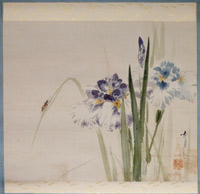
Click here to view image full size.

Click here to view image full size.

Click here to view image full size.
Nishikawa SUKENOBU (1671-1750)
Click here to view image full size.
The pre-eminent painter in the Kyoto area during the first half of the eighteenth century. He enjoyed a great reputation in his lifetime and his (over 100) illustrated books influenced many artists, not only in the Kyoto-Osaka area but also in Edo. Many of his books were published by Hachimonjiya in Kyoto such as Hyakunin joro shina sadame (1723). Other famous books being: Tokiwa gusa (1731); Asakayama (1739); Chiyomi-gusa (1740). His paintings were collected by his contemporaries with Yanagisawa Kien (in his Hitorine, c. 1726) calling him the “supreme master” of Ukiy-e, superior to Okumura Masanobu, Torii Kiyonobu, Hanekawa Chincho and Kaigetsudo. Full colour on silk, 30.25 x 17.5 in; 76.7 x 44.3 cms. Shows a typically refined and elegant beauty watching her assistant washing a tea-whisk in a stream. Suihen bijin zu. There are two other versions of this design by Sukenobu: One was auctioned in 1933 at the Osaka Art Club from the W. Sturgis collection and there is another from Nagano, Japan, illustrated in Kokka, no. 18, 2011, p. 10. Other examples are in major museums such as the Metropolitan, Philadelphia, Freer, Honolulu, British, etc. Although Sukenobu produced many paintings, genuine works are now rare. Painted c late 1730s. Minor marks and creases and some loss of gofun, but in very good condition for an early 18th century painting. Sealed Nishikawa shi in and Sukenobu. Illustrated and exhibited in Nikuhitsu Ukiyoe Beauty, Tokyo Fuji Art Museum, 1983, no. 21, ex Hirano collection, Akita Prefecture.
Very good condition. Signed and sealed Bokusen. See my Blog on this update.
here
Status: Sold
Hasegawa SADANOBU II (active 1867-1880s)
Click here to view image full size.
An original painting by Sadanobu II. A reclining beauty reading a book. There appears to be nothing else like this by Sadanobu, and indeed, there are very few bijin-ga prints by him. A beautiful painting.
Sumi and colour on silk. Image size 13 x 9.25 inches; 33 x 24 cms. Slight loss of gofun and minor marks. Mounted onto board.
Signed Ho Utamaro Sadanobu, “copied [ or imitating ] Utamaro, Sadanobu” with Sadanobu seal.
Status: Sold
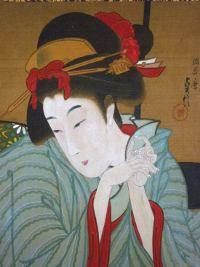
Click here to view image full size.
Toensai KANSHI (Fl. mid-18th century)

Click here to view image full size.
A rare, highly talented and enigmatic painter who produced only a few masterpieces. There is some confusion over his active working life with differing dates from 1748 to 1780, but he was certainly painting in the 1760s. This unusual composition shows a beauty adjusting her hair by obliquely looking in a mirror held by her maid who stares unnervingly straight at the viewer. This painting is well known and is illustrated in Nikuhitsu Ukiyoe, Collection of Ukiyo-e Paintings Classified by Artist and Schools, Vol. 4 (of 10): Katsukawa school, Suzuki Harunobu and Isoda Koryusai, pl. 83, edited and published by Shueisha, 1982. It is also mentioned on page 113 in Ukiyo-e Large Encyclopaedia, Vol. 2, edited by Japan Ukiyo-e Society, published by Taishukan, 1982. Another Kanshi painting showing a beauty collecting bamboo shoots in the snow was exhibited at the Metropolitan Museum of Art, NY, in 2014, in an exhibition: The Flowering of Edo Period Painting: Japanese Masterworks from the Feinberg Collection.
Full colour on paper with mica on the mirror, image size 14.5 x 20 in; 37 x 51 cms. In extremely good condition with double box. Painted c 1765.
Status: Sold
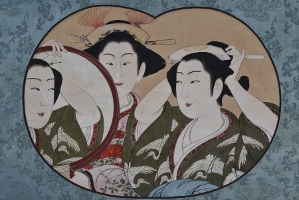
Click here to view image full size.
Kawamata TSUNEMASA (Fl. 1716-48)

Click here to view image full size.
Shows a beautiful salt-water gatherer, her hut behind her on the seashore. A member of the Kawamata school, he probably worked in Kyoto and specialised in bijinga.
Sumi and full colour on paper. Outlines picked out in gold. 32.5 x 10.5 in; 82.5 x 26.5 cms. Fine old brocade mount. Old box. Signed and sealed Tsunemasa.
Status: Sold
Watanabe SEITEI (1851-1918)
Click here to view image full size.
Two geese – possibly Greater White-fronted Geese ( although the legs should be a little more orange ) with tall reeds and a large misty moon. Sumi and light colour on silk, 43 x 16 in; 109 x 40.5 cms. Signed and sealed Seitei. In fine condition with original box signed and sealed by Seitei.
Status: Sold
Katsushika HOKUSAI (1760-1849); Kyokutei BAKIN (1767-1848); Jippensha IKKU (1765-1831)
Click here to view image full size.
An original painting by Hokusai showing the back view of a courtesan. Above are inscriptions by Bakin and Ikku, the two leading writers of the day. ( Bakin is famous for writing Chronicles of the Eight Dog Heroes of the Satomi Clan of Nanso and Ikku for writing the most humorous book in the Japanese language: Shank’s Mare Journey on the Tokaido.) This painting was originally sold at the Tokyo Bijutsu Club, December 3rd, 1928. It is illustrated in Katsushika Hokusai Paintings, Mainich Shimbun, 1975. It is signed Toyo Katsushika Hokusai ga, “Painted by Katsushika Hokusai of Orient” and the seal, Katsushika Hokusai, is the same seal as that used on the pair of hand scrolls, Day and Night, in the Museum of Fine Arts, Boston. Colour and sumi on paper, 11.12 x 11.5 in; 28.2 x 29.2 cms. An intriguing old mount and sold with original sales slip from 1928 and a copy of the 1975 catalogue.
The inscriptions translate as:
I went out dressed up very lightly just to show off for the sake of cherry blossom viewing party.
However, I ended up catching a cold and all my efforts to enjoy the cherry blossoms went for nothing.
Jippensha Ikku
Yoshiwara is located in the north of Mount Kinryu, and it is a very grassy place.
Here I live inside the fence of Miuraya,
I am worshiped by so many guests.
Even though I devote myself completely to seek popularity every day,
I am a louse whose heart cannot be stolen by money alone.
This is my mettle as a courtesan.
Kyokutei Bakin
Status: Sold
Utagawa HARUSADA (1830-1887)
Click here to view image full size.
An exceptionally beautiful painting of a standing beauty by this pupil of Kuniyoshi. An ukiyo-e artist who worked in Kyoto. Real name Okamoto Syotaro. Full colour with touches of gold on silk. Image size 40.5 x 13.5 in; 102.8 x 34.2 cms. Very minor brown area otherwise in fine condition. Signed Harusada ga. Seal unread.
Status: Sold
Kubo SHUMMAN (1757-1820) and Kameda BOSAI (1752-1826)
Click here to view image full size.
An original painting showing a parading oiran on the first day of the eighth month, Hassaku (hachigatsu sakuhi). It was common on this day to wear a white kimono. This festival still takes place in the Gion quarters of Kyoto. The calligraphy, above, is by Bosai (Hosai), an amateur artist and noted scholar and writer. Full colour on silk, 35.25 x 12.5 in; 89.5 x 31.7 cms. In good condition. Signed Shumman painted by himself with Shumman seal.
Status: Sold
Takehara SHUNCHOSAI (Fl. c 1772-1818)
Click here to view image full size.
An original painting showing beauties enjoying the cool of the evening on the riverbank and shallows of the Komo-gawa in Kyoto. An exceptional and rare painting by an artist best known for his guides to Osaka and Kyoto, Miyako meisho zue and Naniwa no kagami, published 1778 and 1780. Full colour on silk, 51 x 19.75 in; 129.5 x 50.2 cms. In very good condition. Signed Bunsei tei inoshishi chushu hatsumikka kyoshinioite Shunchosai Takehara Nobushige. Painted 1818.
Status: Sold
Utagawa TOYOKUNI II (TOYOSHIGE) (1777-1835)
Click here to view image full size.
An original painting on paper, unmounted, showing Asahina Saburo (Wada no Saburo Yoshihide), a famous warrior of the early Kamakura period (1185-1333). Image size 11.5 x 15.5 in; 29.2 x 39.5 cms. Signed Toyokuni suichu hitsu, “Toyokuni painted while being drunk.”
Status: Sold
Matsumura KEIBUN (1779-1843)
Click here to view image full size.
A fine gajo, 10.75 x 6.75 in; 27 x 17 cms, folding out to 10.75 x 13.5 in; 27 x 34 cms. Consisting of 24 paintings in sumi and light colour of birds, animals and fish, starting with the Twelve Signs of the Zodiac: Rat; Ox; Tiger; Hare; Dragon; Snake; Horse; Goat; Ape; Cock; Dog; Boar. Keibun studied with his older brother Matsumura Goshun as well as Maruyama Okyo. Highly talented, especially in kachoga, and went on to consolidate the Shijo style. Original covers and title slip. End sheet signed by the original owner: Sichikudou, Naniwa (the place that was to become Osaka) with his seal. Another unidentified large seal inside front cover. Some slight wormage not affecting any image and some appropriate scuffing of covers; otherwise very good condition. Painted probably late 1830s.
Status: Sold
Tsukioka SETTEI (1710-1786)

Click here to view image full size.
A very fine large painting showing a standing beauty holding a cloth. At her feet is a fulling-block (kinuta) and several mallets. She looks skyward at the geese flying across the moon. One of the traditional symbols of autumn in Japan. There seems to have been a frisson in depicting these beauties fulling cloth near streams, as well as awabi divers and the women of Ohara collecting faggots. Settei produced many illustrated books but after around 1765 turned to painting beauties, courtesans and geishas. They are of the utmost refinement – the faces and limbs picked out in red, their costumes with areas of gold, and invariably have the wide lantern-locks (toro-bin) hairstyle. All these characteristics are found here. Full colour on paper, image size 48.75 x 18.25; 124 x 47.5 cms. Painting and mount in extremely good condition. The box comes with a registration form showing the work seems to have been put up for sale at the Tokyo Bijutsu Club in Tokyo about 70 or 80 years ago. Painted c 1770. Signed Shinten’o gihitsu (painted for amusement by Shinten’o). Seals Hokkyo Settei and Kidashi (family name).
Status: Sold
Tsukioka SETTEI (1710-1786)
Click here to view image full size.
An interesting large painting, full colour on paper mounted on a wooden frame, 25.5 in; 62cms in diameter showing a bust portrait of a beauty with elaborate coiffure holding a child and a rattle. Although not signed, the attribution is unquestionable, painted between 1767-1773 in Osaka. It appears to have been commissioned to hang in a hairdresser’s or cosmetic shop and has metal eyes at the top. The oxidised silver leaf background was meant to resemble a mirror and the idea of busts reflected in mirrors and silver grounds was later employed by Utamaro and Sharaku. Apart from silver, gold leaf and gum is applied. Such signboards appear in an illustrated book by Hasegawa Mitsunobu published in Osaka in 1752. This new discovery has been written about by Dr. Yamamoto Yukari in vol.27 of Minzoku Geijutsu (Ethno-Arts) in 2011. Minor surface marks all over but astonishingly good condition given their age and use. Extremely rare.
Status: Sold

Click here to view image full size.
Teisai HOKUBA (1771-1844)

Click here to view image full size.
An original painting on silk in full colour. Image size 36.5 x 13.5 in; 92.75 x 34.25 cms. A fine painting showing beauties from different social strata: A farmer’s wife; a courtesan; an elegant wife; and a Heian period court beauty. Hokuba was one of the earliest and best of Hokusai’s pupils. A printmaker, but only of surimono, book illustrator, and, most importantly, a fine painter. Above is a kyoka poem by Ota Nanpo (1749-1823), a famous poet and fiction writer. Silk slightly browned and minimal loss of some pigment but in otherwise good condition. Old mount: Would benefit from remounting. Painted Bunsei period, c. early 1820s.
Signed Teisai Hokuba ga with seals Hoku Ba.
Status: Sold
Utagawa KUNINAO (1793-1854)

Click here to view image full size.

Click here to view image full size.
A pair of original paintings: One showing a beauty being followed by her servant down a jetty into a waiting boat. He protects her with an umbrella in one hand and carries food on a tray with the other. The whole scene under heavy snow. The other painting shows a beauty composing a poem. Above a wild goose flies before a full moon. Probably originally two of three setsu-getsu-ka, “Snow, Moon, Flowers.” A theme popular with ukiyo-e artists and originally derived from China. Kuninao studied under Toyokuni and then Hokusai and is also known for many illustrated books. His paintings now rare. Each painting full colour on silk, image size 36.5 x 12.75 in; 92.5 x 32.5 cms. In excellent condition. Beautifully presented with new mounts. One painting signed Kohsoen hitsu with seal Shohzan.
Status: Sold
Utagawa HIROSHIGE (1826-1869)

Click here to view image full size.

Click here to view image full size.
A pair of original kakejiku with two paintings on each. Possibly from the front and back cover pages of a first edition “One Hundred Famous Views of Edo” set. Sumi and colour, image size of each painting 13.5 x 8.75 in; 34.25 x 22 cms. Shows top left a bowl with – possibly – turnips and a poem. Below a wicker basket and bowl with a miniature plum tree and an adonis plant (the most popular plants for the New Year). On the right, at the top are two chidori with poem and below a sake barrel and a plum branch. The bottom two paintings are signed Hiroshige with Ichiryusai seal. In fact, there is another version of the chidori painting associated with a painting of a kago and lantern illustrated in the exhibition catalogue, Hiroshige – A Poetic Ukiyo-e Artist, Fukushima Minpo, 1971, no. 16. These are also possibly from the ends of a first edition set of prints. Hiroshige and Hiroshige II were known to make these paintings, presumably for special clients. Provenance: Ex Takeoka Toyota collection (1844-1931). The box dated (Taisho 11, 1922) and guaranteed by him. He was a famous collector from the Meiji to early Showa era. Paintings and mounts in very good condition.
Status: Sold
Katsushika HOKUSAI (1760-1849)
Click here to view image full size.
A small original painting of an old sage (possibly the poet Saigyo Hoshi [1118-1190]) seated, holding a bamboo pole and with a large hat on his back. He looks up wistfully at a mountain range with what appears to be a hanging bridge over a gorge. Light colour on silk; predominantly the pink, brown and sumi tints he was fond of. Image size 7.5 x 5.75 in; 19 x 14.5 cms. Provenance: From the estate of Jeanne Nicole Ledoux, daughter of Jean Pierre Ledoux, who was the son of the famous ukiyo-e collector Louis V. Ledoux. Mounted as a kakemono. In good condition. Signed Hachijukyusai Manji hitsu, “Brush of old man Manji, aged eighty-nine years.” And with seal Hyaku (“Hundred”). A fan painting in the Museum of Fine Arts, Boston, acc. No. 11.7470, has the same seal and signature.
Status: Sold
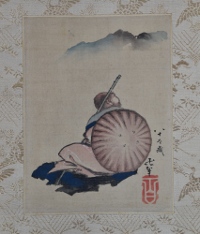
Click here to view image full size.
Tsukioka YOSHITOSHI (1839-1892)

Click here to view image full size.
An original painting, sumi and touches of red on paper, 26 x 11.5 in; 66 x 29.2 cms. A spontaneous painting of a beauty raising the hem of her kimono as she rushes to an appointment. Several small restorations only viewable obliquely, otherwise good condition.
Signed in cursive script which he used from 1887: Yoshitoshi ga. Small seal too indistinct to read.
Status: Sold

Click here to view image full size.
Hishikawa MORONOBU (C. 1618-1694)
Click here to view image full size.
An important figure and pioneer of the ukiyo-e school. He was born into a family of embroiderers and textile dyers at Hota in Awa Province, but departed for Edo, c. 1658, to study painting. A prolific artist, he illustrated a large number of books, as well as being the first to design single-sheet prints. Turned to painting c. 1670. Shows a promenading beauty, knees slightly bent and the long face typical of Moronobu. The delicately painted kimono has serrated roundels with images of Heian court life or abstract patterns interspersed with small gold flower heads.
An original painting on silk, image size 23.5 x 10.75 in; 59.75 x 27 cms with an old elaborately embroidered mount. Unsigned, as is often the case with 17th century paintings. In very good condition.
Status: Sold
Matsumura KEIBUN (1779-1843)

Click here to view image full size.
A handscroll comprising twelve mostly nature studies. ( Four shown. ): An isolated village; redstart and camellia; a rock; iris; rose; bamboo; lobster; sparrow and begonia; a village covered in snow; a scholar reading; white camellia; hibiscus. Sumi and light colour on paper, 14 x 441.2 in; 35.5 x 1120 cms. Keibun was a leading Kyoto artist who had many talented pupils. He studied with his older brother Matsumura Goshun and also Maruyama Okyo. The paintings show all the spontaneity and brevity of a leading exponent of the shijo school and the subject matter is typical. Minor marks; slight edge damage on one painting, but generally good condition. Each painting sealed Kei Bun . Ivory rollers and stickered box.
Status: Sold
Katsushika HOKUSAI (1760-1849)
Click here to view image full size.
An original painting by Hokusai showing wild boars, a parent and baby. Another “Wild Boar in the Moonlight” painting is in the Museum of Fine Arts, Boston, acc. No. 11.7430, ex William Sturgis Bigelow collection. The same broad background brushstroke shading is found on both paintings. Illustrated in Idemitsu Museum of Arts, vol. 9, Ukiyo-e Paintings, Kikuchi Sadao, 1976, pl. 84, p. 57. It was originally in the inventory of Yabumoto Soshiro, the largest antique dealer in Tokyo after he moved from Kyoto in the second half of the 20th century. Sumi and light colour on paper, 12.75 x 22 in; 32.4 x 56 cms. Signed Gakyorojin Manji hitsu rei hachi-ju-ichi (“at the age of 81”) with Fumoto-no-saki seal, so probably painted for the year of the boar, 1839. There are other paintings with the same signature and seal, e.g. The Harari Collection of Japanese Paintings and Drawings, volume 2, Jack Hillier, Lund Humphries, 1970, no. 142 “The Comet,” p. 258.
In very good condition. Recently remounted and sold with the old Edo-era box.
Status: Sold
Kishi RENZAN (1805-1859)
Click here to view image full size.
An original painting by Renzan, also known as Gantoku. He was adopted by the Kishi family and trained by his father-in-law, Kishi Ganku, who founded the Kishi school. His fellow pupils were Yokoyama Kazan and Minwa Bumpo. After Ganku’s death, he became the leader of the school together with Gantai. Highly regarded in Japan, he painted the walls of the Room of the Wild Geese in the Kyoto Imperial Palace. Shows a fierce tiger, very much in the style of Ganku. This subject is usually found as a diptych with a dragon. But this painting seems to stand alone and was probably painted for a year of the tiger, 1842 (?). Sumi and light colour on silk. 37 x 14 in.; 94 x 35.5 cms. Interestingly, Renzan designed a surimono of this subject also for a Tiger year, 1842 or 1854.
Signed Kishi Bunshin with upper seal Kishi Bunshin and lower seal unread. In good condition although mount somewhat creased.
Status: Sold
Teisai HOKUBA (1771-1844)
Click here to view image full size.
A large original painting, full colour on paper, 49 x 22.5 in; 124.5 x 57 cms. Shows a beauty caught in an autumnal breeze, the tree above shedding its leaves. One of Hokusai’s earliest and best pupils and, apart from painting , is also known for his surimono and book illustration. Famous for his meticulous paintings of beauties, Hokuba also produced these loose impromptu paintings using rapid brushstrokes. Painted in Bunka period (1804-1818).
Some slight rubbing of paper at top, but in surprisingly good condition given its size. Newly mounted. Signed Hokuba ga with Hokuba seal.
Status: Sold
Tsuji HOZAN (Fl. 1820-1840)

Click here to view image full size.
An original painting, 31.5 x 12.5 in; 80 x 31.8 cms. Sumi and full colour on silk. The inscription on the inside of the box lid states that the painting is by Tsuji Hozan, a Shijo painter, and shows a “castle-toppling” courtesan under cherry blossom in the style of Toyokuni. (Castle-toppling is a term used for high-ranking courtesans who could, because of their beauty, cause havoc and influence the regimes of men of great power. [See Yoshitoshi’s Women, John Stevenson, Avery Press, 1986, p. 48, no. 10, “Looking feminine” from the set “Thirty-two Aspects.”]) Hozan is known for the fine illustrations to Bitchu meisho-ko (1822) and there is a fine pair of paintings in the BM, acc. no. 1983.1111, 0.3.1-2. However, there is some thought that Hozan was a pseudonyme for Aoi Sokyu (Shuho). Certainly, this pure Ukiyo-e painting shows great competence. Signed Hozan hitsu with seals Hozan and Dojin. In fine condition. Also, on the inside of the lid is a guarantee from Zangetsu’an Studio.
Status: Sold
Kawamata TSUNEMASA (Fl. 1716-1751)

Click here to view image full size.
An original painting, sumi and full colour on paper, 27 x 10.5 in; 68.5 x 26.75 cms. Shows a parading courtesan with her kamuro. Tsunemasa’s small corpus of work shows him primarily painting portraits of beauties as well as mitate works alluding to classical themes. His delicate figures may have been an influence on Harunobu. Painted c 1745. In very good general condition. Signed Tsunamasa hitsu with Tsunemasa seal.
Status: Sold

Click here to view image full size.
Kitagawa UTAMARO II (Fl. c 1807-1830s)

Click here to view image full size.
An original painting, sumi and full colour on silk, 40.25 x 15.25 in; 102.25 x 38.75 cms. Shows a geisha reading a book and holding a shamisen likened to Manjusri (Japan: Monju), the bodhisattva of wisdom in Mahayana Buddhism. Often depicted riding or astride a lion representing the use of wisdom to tame the mind. As here where she straddles a large almost human-looking Shishi lion. Very few paintings by Utamaro II exist. See Bonhams auction, London 11/11/2010, lot 357. Also three bijin in Boston illustrated by Tsuji Nobuo in Nikuhitsu ukiyoe, Ukiyo-paintings: Museum of Fine Arts, Boston, Kodansha 2000, pl. nos. 6, 8, & 9. And a standing courtesan (yujo risshi zu) in the Tokyo National Museum, Japan. Viewing the paintings it’s evident Utamaro II was highly competent, not something we are aware of when comparing his prints to the work of Utamaro I, which are generally poor in comparison. Comes with a double-box, the second box inscribed “Painted by Utamaro II. A picture of a high-class geisha reading likened to Monju.” Inside the lid a guarantee from Kimura Suetsuke (a dealer and Ukiyo-e expert) dated 1979 (June of the sixth year of the sheep in the Showa period). Some slight loss of gofun but in good general condition. Signed Utamaro fude with two unread seals.
Status: Sold
Watanabe SEITEI ( 1852-1918 )
Click here to view image full size.
Seitei ( Shotei ) specialised in kachoga; was famous in this area, and regarded as the leading exponent. Technically brilliant. Shows two tancho ( “red crest” ) Japanese cranes flying down to a field suffused with the yellow of ripening rice. This crane ( Grus japonensis ) is the second rarest crane in the world, migrating to East Asia in the fall to spend the winter. There is also a resident flock in Hokkaido. Much loved by the Japanese, the crane was a symbol of luck, longevity and fidelity.Full colour on silk, 46 x 19.5 in; 117 x 49.5 cms. One small spot and minor loss of gofun on the rice, otherwise very good condition.
Signed and sealed Seitei. A beautiful composition.
Status: Sold
Katsukawa SHUNSHO ( 1726-1792 )
Click here to view image full size.
An extremely important painting by one of the most important artists of his day. One of the great ukiyo-e print designers – especially of actor prints. He lived in Edo and first studied under Katsukawa Shunsui and Ko Sukoku. Little is known of his private life. He had many able pupils including Hokusai. The seal he used had Hayashi on the side of a jar ( tsubo ), hence he was called Tsubo. In 1776, together with Kitao Shigemasa, illustrated the famous book Seiro bijin awase sugata kagami. Also the Ehon butai ogi with Buncho in 1770.
This was one of the paintings chosen to be exhibited at the Isetan Department Store to commemorate the Tokyo Olympics in 1964. The exhibit arranged by The Mainichi Newspapers. A committee consisting of Mr. Seiichiro Takahashi, president of the Japan Art Academy, Mr. Issho Tanaka, director of the Tokyo National Cultural Assets Research Institute, Mr. Seiroku Noma, an historian, Mr. Muneshige Narasaki, chairman of the Ukiyoe Association, Mr. Sadao Kikuchi of the Tokyo National Museum, Mr. Teruji Yoshida, an Ukiyoe connoisseur, Mr. Fusui Kaneko, an Ukiyoe connoisseur, Mr. Yasunosuke Ogiwara, an Ukiyoe connoisseur, and other collectors vetted all the paintings and they represented the best that could be put together at the time. Full colour on silk including gold leaf. Exquisitly painted. Slightly creased otherwise in good condition. Double box with inscription in gold. Image size 39 x 12.5 in; 99 x 31.75 cms. Painted c 1781-9.
Signed Katsu Shunsho ga with seal. Ex collection Oda Eisaku, a famous art dealer and collector.
Status: Sold















